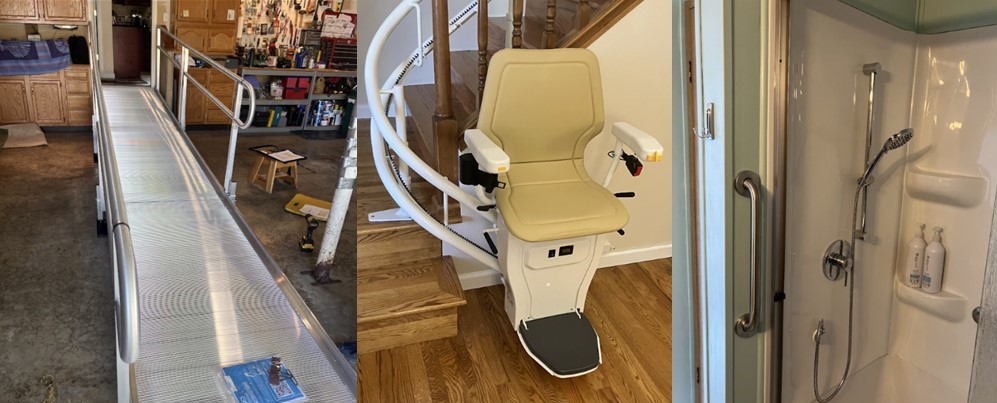Aging in place and disabled care are fast-growing markets as more and more people choose to modify their homes as opposed to moving into an assisted care community. As the US population ages, solutions to enhance the safety, security, and quality of life of the home's physical environment provide for an aging in place solution that is preferred by many facing aging and disabilities.
Helping Hands Living Solutions recognizes that all aging in place solutions will be uniquely tailored to each home and lifestyle. We work to provide options on various solutions that we have extensively researched. Then we provide a customized proposal to suit your current needs, as well as have adaptability for future concerns. Our ultimate goal is to advise on the available market of solutions, focused on safety, security, and quality of life, to allow for our clients to stay in their homes as long as humanly possible.
The Smart Home Advantage
Smart home devices are not a replacement for human care, but they can be a reliable tool for aging in place. These devices can be powerful problem solvers, enhance convenience and comfort, while boosting safety and peace of mind.
The devices available for a smart home system are endless, but Helping Hands Living Solutions want to stress the ones we see as most advantageous for aging in place:
Smart Hub
A smart hub allows your smart devices to operate through a central command unit. This consolidation of all your smart devices allows for simplification of use as well as interoperability for your smart home solution. The most popular platforms are Amazon Alexa, Apple Home, Google Home, Matter, and Samsung SmartThings. Many smart devices allow you to control them using at least one and often several of these platforms simultaneously. When utilized with a Smart Display, the control and monitoring of your devices is available for you to simplify your life in the home.
Smart Security Cameras
Smart security cameras are the eyes of your smart home. Having visual access to your on-line cameras allows you to see into the rooms of your house, garage, and outdoors using your smart phone, smart TV, or various other smart display devices. Smart cameras help you keep an eye on your home while you’re away. As you age, family members can also access smart cameras (with your permission) to monitor for falls or other emergencies.
Doorbells and Smart Locks
Video doorbells add security to your home and can connect to compatible smart hubs. These doorbells connect to an app on your smartphone or other smart display and notify you when someone is at your door or enters a specified perimeter of the yard or street. Many video doorbells also record and save video footage.
Smart locks can lock and unlock doors via a smart hub, voice command or remotely using a smartphone. Smart locking systems can help seniors when family members are checking in on them since they don’t need a key—just a password, code or the ability to unlock the system from an app. Smart locks let you live key-free if you like, and they also allow others to have access to your home without difficulty. A smart lock can also be helpful if you’re caring for a loved one who tends to wander, or if you just want to make sure the house is locked up for the night
Smart Lighting and Smart Plugs
Smart light fixtures and smart bulbs let you turn the lights in your home on and off remotely with sensors or by using voice activation or other controls through a smart hub. With smart lighting options, you can turn lights on and off simply by voice command without having to find your way to light or lamp switches. You can also turn smart lights on and off remotely for better home security while away.
Smart plugs provide traditional electrical devices with smart controls to provide any device you plug in with controlled power. Plug one into an electrical outlet, assign it in your Smart Home system with a name, and then connect a table lamp, a fan, or another on/off device to the smart plug. You can now remotely turn your device on or off or put it on a repeating schedule.
Emergency Alert Systems
Many medical alert systems require the user to wear a pendant, watch or other wearable so they can push a button or speak to alert the company’s monitoring center if they fall or have a medical emergency. These systems typically use a landline or cellular network. However, some medical alert systems also work through voice activation in the home, using their own hub. Their are options to integrate your Medical Alert device into your Smart Home system to enhance its functionality.
Smoke and Carbon Monoxide Detectors
Everyone has working smoke detectors throughout the house, but there’s a particular concern as to whether someone with reduced hearing will notice an alarm—and how quickly they might react to it. Smart smoke detectors not only deliver an audible siren inside the house but can also send alerts to friends, neighbors, and caregivers. Also, using the smart home hub, a triggered smoke alarm can activate a bed vibrator to wake you from your sleep.

